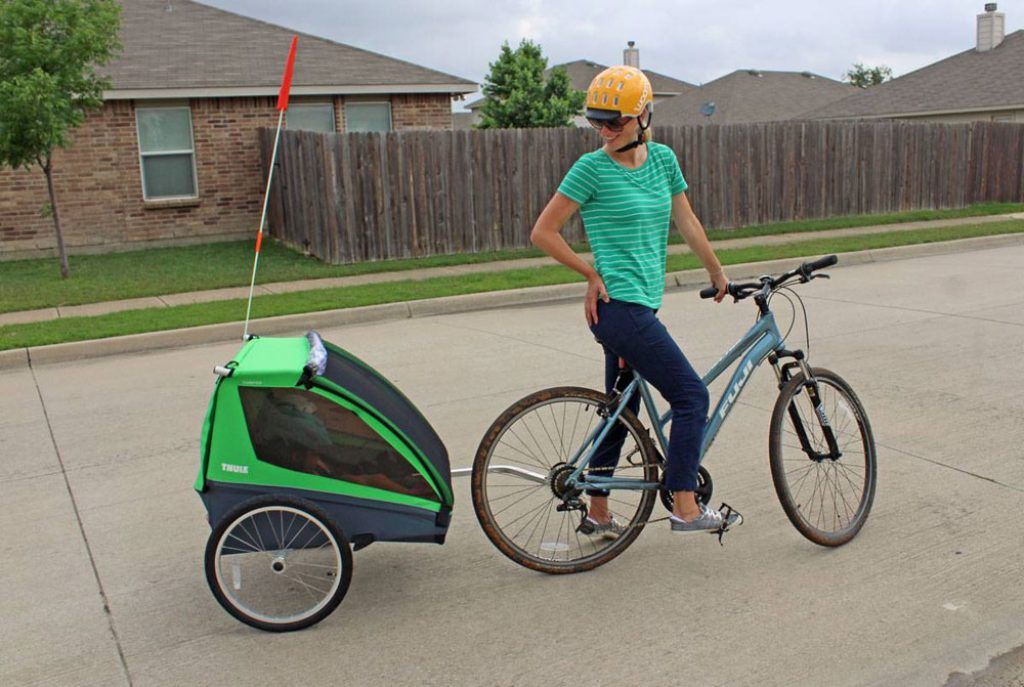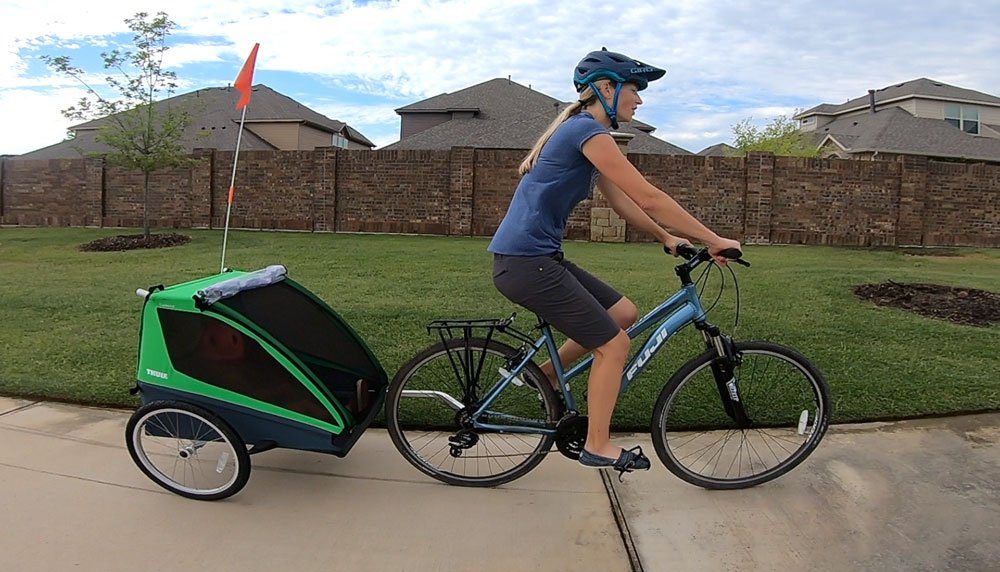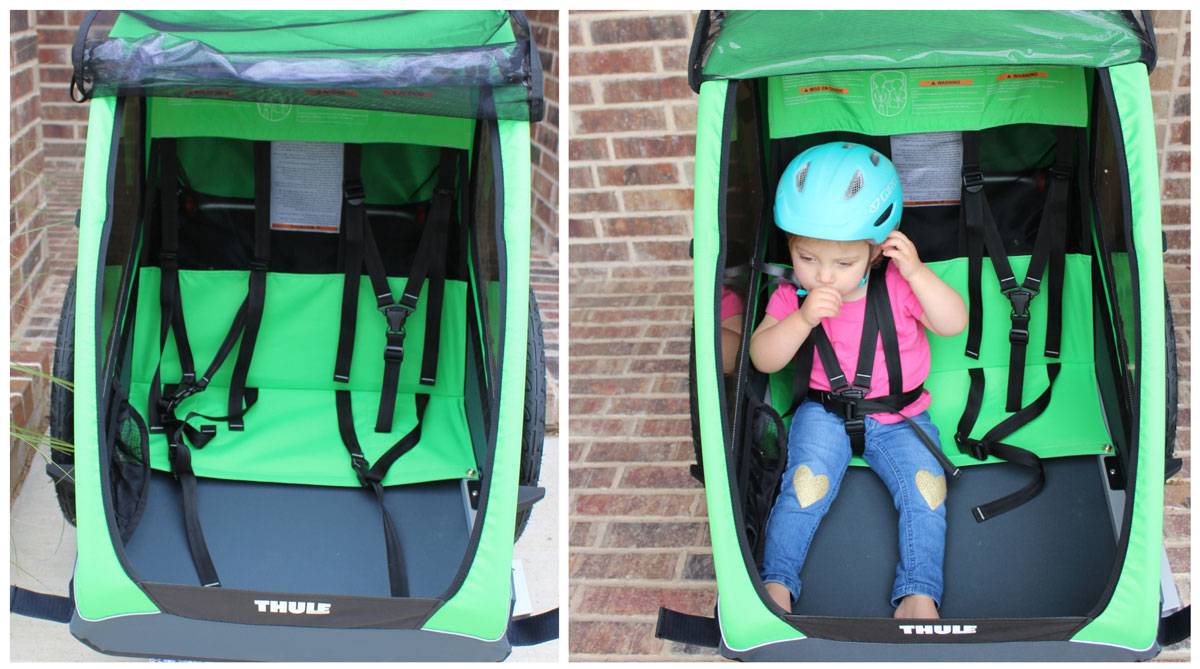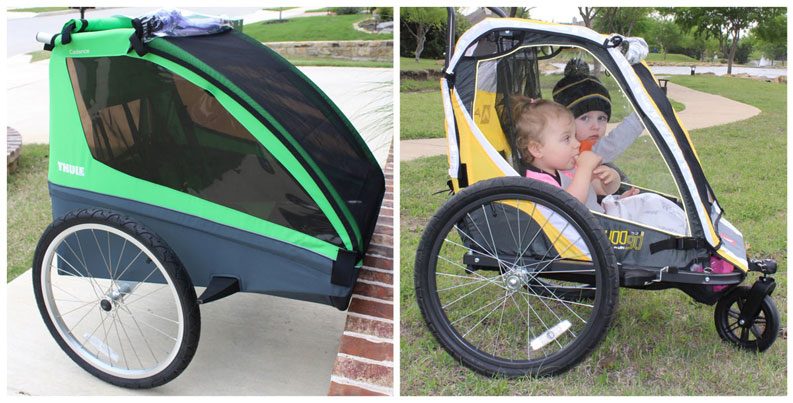With the design and durability of the Thule name, the Thule Cadence is a high-quality basic trailer without a big price tag. In this review, we put the Cadence to the test with several other top-selling trailers to see how it stacks up!

Thule Cadence Trailer Overview

RATING: Recommended
MSRP: $449
BEST FOR: Families on a budget who need a trailer for frequent paved trail use.
SPECIFICATIONS
TRAILER CAPACITY: Double
TRAILER ARM: Included
JOGGER KIT: Not available
STROLLER KIT: Not available
WEIGHT: 22 lb.
UV WINDOWS: Yes
TIRE SIZE: 20”
INSIDE HEIGHT: 23.6″
INSIDE WIDTH: 21.5″ (Shoulder width)
PROS:
- Exceptionally smooth ride for biking
- Beautiful, clean lines for a sleek look
- Low mesh helmet recess ideal for the youngest riders
- Sunshade – only trailer to have one at this price point!
- Rear canvas folds up for better ventilation
- Thule hitch system is so easy to use!
CONS:
- Separate lap and shoulder buckles make loading kids more complicated
- No tire upgrades for use on rough terrain
- Difficult to fold
Thule Cadence Review – Results of Our Test Rides
The Cadence is Thule’s basic trailer, offering the durability and quality that come with the Thule name, but at a price tag that won’t sticker-shock you. 🙂 While we’ll sing the praises of the luxury Thule Cross all day long, not everyone wants to pay $1,000+ for a bike trailer!
If you’re a fan of Thule’s sleek and modern European design, the Cadence is a perfect entry-level option for active families. Coming in under $450, this double trailer can’t convert to a stroller or jogger, but keeps things simple to keep costs down. While it may be Thule’s “low-cost” trailer, it certainly blows budget trailers like Schwinn and InStep out of the water.

Overall Performance
If you haven’t used a lot of bike trailers, it’s hard to know what you really should pay extra for. Luckily for you, we’ve tested more kids bike trailers than probably anyone and can confidently say that a “budget” trailer from Thule is worth an extra $300 over a Schwinn or InStep.
Thule trailers pull smooth and easy. You don’t hear them behind you clack-clacking over every sidewalk line. The tow arm inserts tightly into the body of the trailer so it doesn’t clack around either. Smooth and quiet are two qualities of trailers that make a world of difference. The Cadence is both.
The Cadence can certainly handle occasional dirt trails, but is better suited for paved roads. If you’re interested in a trailer that’s also a stroller, check out the Thule Coaster XT, which is basically the Cadence with a stroller wheel.

Interior Space
With 21.5″ of shoulder space and 22.5″ of seat width, the Thule Cadence is equivalent in size to high-end trailers like the Burley Encore. One child rider can cruise in comfort, two young riders cozy up nicely, and older riders might feel a bit squished. On the left below you see our 19-month-old tester in 2T clothes with her friend in 3T clothes. On the right we have a different tester with 4T clothes.
Like the other double trailers by Burley and Thule, the Cadence has a 100 lb. weight capacity, which you’d have a pretty hard time maxing out and while still making sure the kids are comfortable.
18-Month-Old with 3-Year-Old vs. 4-Year-Old

The headroom of the Thule Cadence is definitely sufficient, but as we’ll talk about in more detail below, the low helmet recess pocket is great for young riders, but doesn’t extend high enough for riders over about 4. The rider in the blue helmet below is in 4T clothes.
Legroom is also decent, but as you see on the right below, our 4-year-old rider does have her knees raised quite a bit. Some trailers, like the Burley Bee, actually have a lowered foot space so older kids can still extend their legs.
Overall, the Cadence is ideal for smaller riders starting at 12 months as they grow into 4T clothes. Clearly they can ride past 4T, but the Cadence has the most room for comfortable growth if you buy it when the kids are younger.
Headroom and Legroom in Thule Cadence

Mesh Helmet Recess
Any trailer worth its salt has loose mesh behind children’s heads. This allows the back of their helmets to recess into the back of the seat and prevents their heads from being pushed forward. The Cadence’s helmet recess pocket starts lower than any other trailer we’ve seen. This makes is uniquely appropriate for the youngest and shortest of riders.

Our rider below is a tall 18-month-old in 2T clothes. On the left you can see that even the uber-popular Burley Bee‘s helmet pocket barely accommodates her at this age. It wouldn’t be low enough for best-in-class comfort for your average 12 – 18 month-old. (Remember – kids can’t ride in a bike trailer until they are 12 months!!) On the right you see the Schwinn Trailblazer, which has a very high helmet pocket.
Burley Bee vs. Schwinn Helmet Recess

However, the Cadence’s helmet pocket isn’t nearly as tall as many other trailers, so as kids grow older they will outgrow this particular feature of the trailer more quickly. This makes the Cadence the most ideal for toddlers and kids 12 months to approximately 3 years old.
The green fabric top of the back of the seat is a bit loose, though, so it does still provide some wiggle room to account for bulky helmets. As always, we recommend buying a helmet with a flat back (like the Giro Scamp!) if your child will be doing a lot of trailer riding.
Seats and Trailer Bottom
The double capacity Cadence accommodates two passengers on a hammock-style seat. Being a basic trailer, there are no seat or shoulder pads.

Hammock-style seats are standard for low-cost trailers and are made from a thick piece of fabric being pulled taut between the sides of the trailer. Below you can see the difference between the Cadence’s hammock seat and an upgraded bench-style seat on the right.
Hammock-style seats sag and are minimally supportive, making it a bit less comfortable for the rider and more difficult for the adult to strap a child in. It’s also a bit more awkward with two passengers because they tend to sink towards the middle with hammock seats.

Many hammock-style seats on cheaper trailers sag so significantly that you can see the little bums poking out beneath the trailer. As seen in the image below, Thule’s hammock-style seat actually doesn’t sag at all beneath the trailer. (Yes, our tester is sitting in the Thule!)

Harness System
The buckle and harness system on the Cadence is more rudimentary than the Burley Bee or even the budget Allen S2 trailer. As seen below, the Burley Bee is a 5-point system that converges into one easy-to-use buckle.
The Cadence has two separate buckles – one for the shoulder and crotch straps, the other for the lap belt. Not the end of the world certainly, but honestly kind of a pain and more cumbersome to use. Anyone else ever have trouble locating straps and buckles under little bums?? We’re not sure why the Cadence has this system, as all other Thule trailers have the more traditional 5-point system similar to the Burley Bee.
Thule Cadence vs. Burley Bee Buckle

Exterior Covers
One of my favorite features of Thule trailers is that they look so tight, sleek, and precise. The entire canvas portion of the trailer is pulled taut and stays permanently in place. The front cover is a mesh door that lifts up to load in the kids, and then secures in place with a strong, high-quality velcro system.

Rain Cover
The rain cover of the Thule Cadence is a permanent fixture on the trailer. When not in use, it’s rolled up and secured at the top of the trailer front door with elastic loops. When needed, you unroll the cover and secure it with the same velcro enclosure as the mesh front door. Super easy to use and always there in case of a weather emergency.

Both rolled up and pulled down for use, the Cadence’s weather cover looks neat and clean. Although the Burley trailers have great weather covers as well, Thule’s look tighter and sleeker.
UV Windows and Sunshade
UV windows are such a useful upgrade from standard budget trailers. Blocking harmful sun rays as well as just helping keep kids cool can make a world of difference in your kids’ enjoyment of the ride. It’s also nice not to have to slather on sunblock every time you want to take the trailer out.

One thing you never get at this price point is a sunshade – except with the Cadence! We were surprised to discover the Cadence’s sunshade because it’s kind of hidden and also, you usually have to pay a few more hundred bucks to get a trailer with a sunshade.
The back cover of the Cadence doubles as a sunshade, which is why we actually missed it the first few days of our testing. You lift the back canvas up and over the front of the trailer, securing it in place on the sides with Velcro. Voila! Now you’ve got a sunshade! It’s actually pretty genius. We’re impressed.
The potential drawback of this design is that it makes the rear storage less secure. If you’re bringing cargo items along for the ride, consider how secure they are before using the sunshade.

Storage Compartment & Rear Venting
Storage space is plenty in the rear of the Cadence. The storage area has a tight, flat bottom that extends up the gray portion of the back of the trailer. The green trailer back secures with velcro over the gray bottom. I personally don’t bring a ton along for the ride and this storage space is plenty sufficient for me.
If you will be bringing large or tall items along regularly, you may want to consider the Burley Bee which has a much deeper storage area than the more shallow Cadence.

While the enclosed storage compartment doesn’t have any rear venting, the back of the storage area can be rolled up and secured at the top of the trailer if rear ventilation is needed. Air can then flow through the mesh helmet pockets.
Wheels
The Cadence’s 20″ wheels on metal rims are good-quality and pretty standard for lower-cost trailers. They’ll do well occasionally on dirt trails, but are meant primarily to excel on paved roads. Unlike Burley trailers, Thule trailers do not have a fat tire upgrade for tackling all-terrain, snow, sand, or gravel.
If you know you’re going to stick to paved trails, the Cadence is a great option. If you’re planning on venturing off the beaten path, the more rugged Burley trailers should be considered.

Mesh Cup Holders
While not necessarily a make-or-break decision, size and placement of mesh cup holders can either be awesome, or kind of a pain. Thule’s are somewhere in the middle, even on their super high-end Cross trailer.
In the Cadence, there’s only one mesh cup holder, which is a little odd for a double trailer. The mesh pocket is placed a little more forward than some other brands, providing more room on the seat for the child, but making it more difficult to reach for the youngest riders.
Additionally, the pocket is wide, which allows plenty of room for storage, but its width can also be a problem because sippy cups tend to tip over and then your toddler can’t get it out.We prefer the mesh cup holders on the Burley which are placed closer to the child and also separated down the middle to create two smaller pockets. This style keeps cups upright and easy to access.
Burley vs. Thule Cup Holder Placement

Folding
While the Cadence folds up nice and compactly for easy storage or transportation, we found its folding system pretty difficult to use. It’s folded by pulling on the red knobs in the rear of the trailer, then pushing inward and downward to collapse the frame.
Easy in theory, but I couldn’t do it without the help of my 8-year-old. It was a 2-man job. Having tested many trailers from high-end Burley and Thule to budget Schwinn and InStep, the Cadence’s folding system has been the most difficult so far.

Hitch Style
Thule trailers have the easiest-to-use hitch system out there. Unique from any other trailer brand, the hitch and tow arm are secured using a ball joint that’s easy to get in and out of the socket regardless of the angle of the adult bike. Every other hitch system requires the adult bike to be fairly upright to align holes in the hitch and tow arm, which can take several tries and a bunch of re-jiggering.

Thule trailers are also unique because the quick release pin in the hitch is locked in place by a piece of rubber that is pulled over and under the hitch and then secured over the end of the pin. Overall, we prefer the Thule hitch system over any other trailer we’ve tested because the process of attaching the trailer to the bike is so effortless and streamlined.

Tow Arm
The Cadence’s tow arm is removable and inserts easily and snuggly into the body of the trailer, secured by a quick-release pin. Many cheaper trailers have tow arms that fold beneath the trailer when not in use. This actually creates a loose tow arm joint that moves and rattles. The Cadence’s tow arm, on the other hand, stays firmly in place which contributes to its overall quite and smooth performance.

Bottom Line on the Thule Cadence
The Thule Cadence has the same sleek lines, easy-to-use hitch, and smooth ride as the more expensive Thule models, but at a fraction of the cost. If you’re looking for a no-frills, basic trailer that’s also high-quality and durable, the Cadence is a great option. You should, however, keep in mind that the dual-buckle harness system is a bit of a pain to use.
FTC Disclosure: Affiliate links are included in this review. No monetary compensation was provided for this review, however, the reviewed product was supplied by the manufacturer or distributor to help facilitate this review. All opinions and images are that of Two Wheeling Tots LLC. All content and images are copyrighted and should not be used or replicated in any way. View our Terms of Use.
